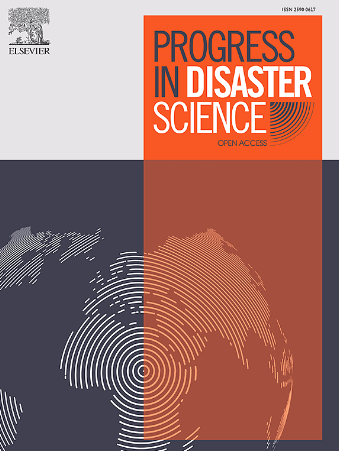孟加拉国锡拉杰甘杰地区贾木纳河流域居民的洪水预警效果
IF 3.8
Q3 ENVIRONMENTAL SCIENCES
引用次数: 0
摘要
洪水是一种普遍存在的全球性自然灾害,在孟加拉国是一个经常性的挑战,对财产、基础设施和生命造成重大损失。自 1972 年以来,孟加拉国实施了洪水预警系统,重点关注人员、财产和成本效益。然而,该系统的有效性有赖于准确、及时地发布预警,以及面临风险的社区迅速做出反应,以减少损失和损害。本研究评估了 Sirajganj 区基层洪水预警系统的有效性,特别是在 Kaijuri 联盟内有针对性地选择的两个村庄。其中一个村庄位于未受保护的岸线沿线,而另一个村庄则位于岛屿 char 区。通过访谈、焦点小组讨论和关键信息提供者访谈从 116 户家庭收集了数据。多重标准分析的结果显示,该系统对岸线村(Kaijuri)的效果一般,得分为 0.400,但对焦炭地村(Thutia)的效果要差得多,得分为 0.174。通讯联系不足导致信息延迟和不可靠,从而造成更大的损失和破坏。这项研究强调,为了更有效地降低风险,有必要让社区参与洪水预警系统的规划和管理,从而建立社区信任。本文章由计算机程序翻译,如有差异,请以英文原文为准。
Effectiveness of flood early warning for the Jamuna char-dwellers at Sirajganj District in Bangladesh
Floods, a pervasive global natural disaster, are a recurrent challenge in Bangladesh, causing substantial damage to property, infrastructure, and lives. The country has implemented a flood warning system since 1972, focusing on people, property, and cost-effectiveness. However, the efficacy of this system relies on accurate and timely dissemination of warnings and prompt responses from at-risk communities to mitigate losses and damages. This study evaluates the effectiveness of the flood early warning systems at the grassroots level in Sirajganj District, specifically in two purposively selected villages within the Kaijuri Union. One village is situated along the unprotected bankline, while the other is in the island char area. Data was gathered from 116 households through interviews, focus group discussions, and key informant interviews. Results of the Multi-criteria analysis reveal that the system is moderately effective for the bankline village (Kaijuri) with a score of 0.400, but considerably less effective for the char-land village (Thutia) with a score of 0.174. Inadequate communication links contribute to delayed and unreliable information, leading to higher losses and damages. The study emphasizes the necessity of building community trust by involving them in the planning and management of flood warning systems for more effective risk reduction.
求助全文
通过发布文献求助,成功后即可免费获取论文全文。
去求助
来源期刊

Progress in Disaster Science
Social Sciences-Safety Research
CiteScore
14.60
自引率
3.20%
发文量
51
审稿时长
12 weeks
期刊介绍:
Progress in Disaster Science is a Gold Open Access journal focusing on integrating research and policy in disaster research, and publishes original research papers and invited viewpoint articles on disaster risk reduction; response; emergency management and recovery.
A key part of the Journal's Publication output will see key experts invited to assess and comment on the current trends in disaster research, as well as highlight key papers.
 求助内容:
求助内容: 应助结果提醒方式:
应助结果提醒方式:


